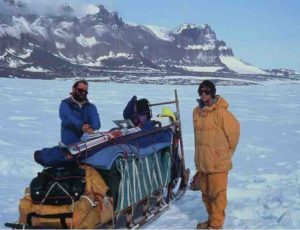
It’s a white Christmas with a difference for an international gang of scientists heading from McMurdo Base to the Transantarctic Mountains in a gruelling hunt for fossils older than dinosaurs.
Among them is Flinders University Strategic Professor in Palaeontology John Long, who twice ventured to Antarctica in the late 1980s and early 1990s.
In a bid to explain the transition of vertebrate life from the water to land, Professor Long has joined a new multi-year expedition funded by the National Sciences Foundation to scour the rocky, dry, desert-like valleys between Antarctic glaciers to piece together the path of evolution.
While most of Antarctica is covered by a deep sheet of ice, the Transantarctic Mountains reach up above the ice and expose pristine sheets of sedimentary rock that are in places rich in fossils.
The team, including Professor Neil Shubin from the University of Chicago, Associate Professor Adam Maloof from Princeton University, Australian National University’s Professor Tim Senden and Ted Daeschler from Drexel University in the US, are looking for well-preserved Devonian fish fossils in this remote location.
“We are looking for Late Devonian (up to 390 million year old) fossils, including fossil sharks and lobe-finned fishes that have been recently discovered in Canada’s Arctic,” says Professor Long.
“Following on from Neil Shubin’s work on Tiktaalik, we hope to find similar fishes down in Antarctica.
“Well-preserved Devonian fish fossils shed light on the big question of how did fishes evolve into the first four-limbed land animals (tetrapods, or early amphibians).
“There are also well-preserved placoderms and very old fossil sharks, so we could find out a lot about the early radiation of the first jawed fishes.”
The Devonian Period ended approximately 120 million years before the first dinosaurs appeared. It was a time when fish were diverse and abundant and fossils from that period have provided important clues to how life adapted and made the transition from the water to land.
The 375-million-year-old Tiktaalik roseae fossil is a key transitional form between fish and land animals, published as the cover story in Nature in April 2006.
The Antarctica research will continue through to mid-January 2017 and continue in the summer of 2018-19. As well as the centres of evolutionary change, the expedition hopes to find species new to science.”
Filling in the gaps in the incompletely-known Late Devonian interval will also help to answer questions about the diversification of major groups of fishes, the origin of limbed vertebrates, along with the invasion of land by plants and animals.
Professor Long tells of sub-zero conditions and hazardous climbing conditions in his book Mountains of Madness (Joseph Henry Press, 2001) about his earlier expeditions. His other book, Frozen in Time, is the first book to give a complete overview of Antarctic palaeontology (CSIRO, 2011) .
He survived the earlier experience to become President of The Society of Vertebrate Palaeontology, author of hundreds of scientific papers and even adult and children’s books about fossils.
He has earned an international reputation for finding the world’s oldest vertebrate embryo and uncovering the origins of sex after analysing the sexual reproduction of 385 million year-old fossilised fish found in Scotland.
Along with cold-climate fossil hunts, he is a pioneer of the remote and very hot Gogo fossil site in northern Western Australia. The perfectly preserved 3-D fish fossils have yielded many significant discoveries, including mineralised soft tissues, the origins of complex sexual reproduction in vertebrates.
His discoveries include the State Fossil Emblem of WA (Mcnamaraspis), the mother fish with the world’s oldest vertebrate embryo (Materpiscis), a tetrapod-like fish with large holes on top of its head for air-breathing (Gogonasus), and the oldest evidence for copulation in vertebrates (Microbrachius). He has published seven papers in Nature and Science in the past 10 years, with four of these first authored.
Note: The above post is reprinted from materials provided by Flinders University.










